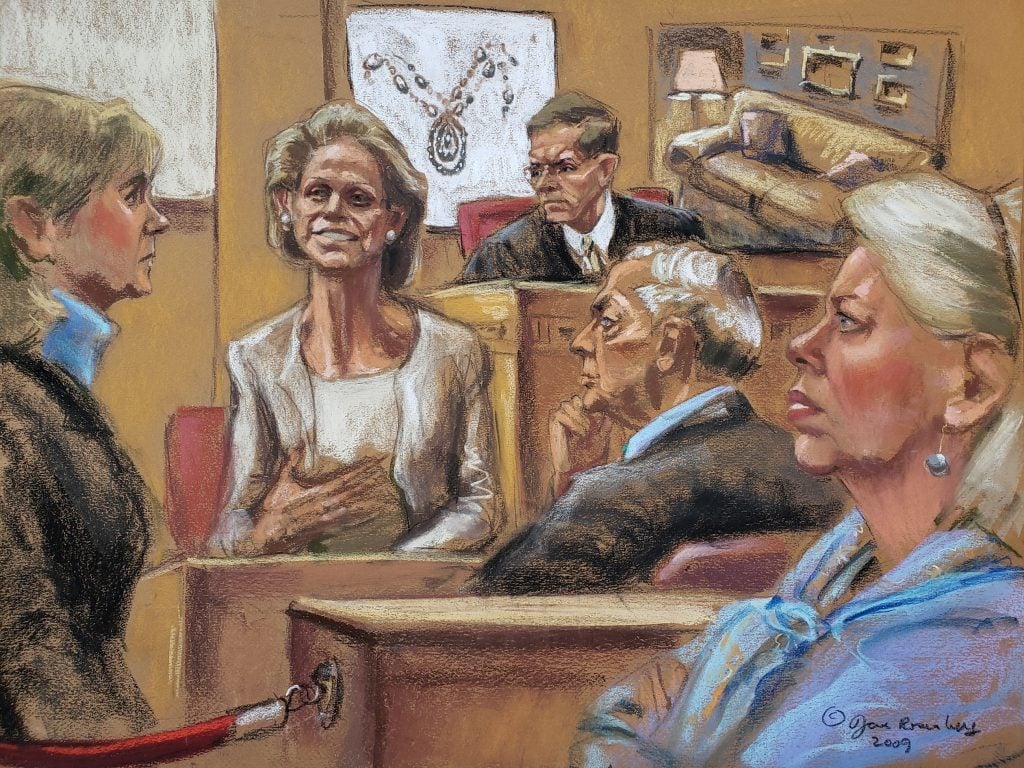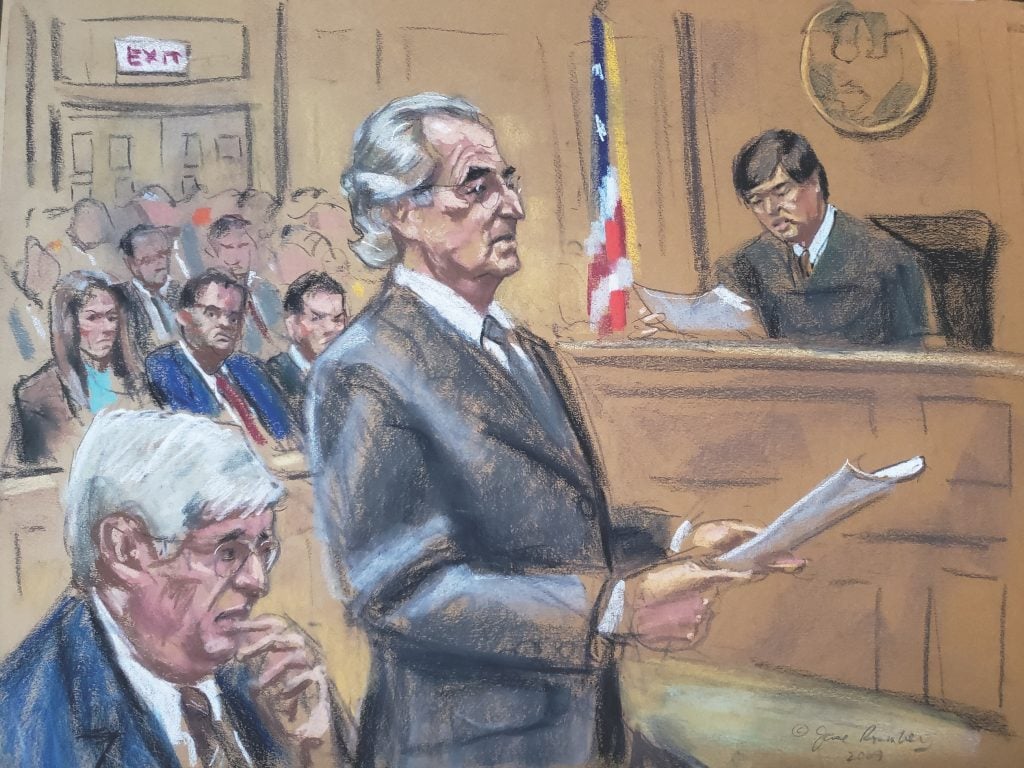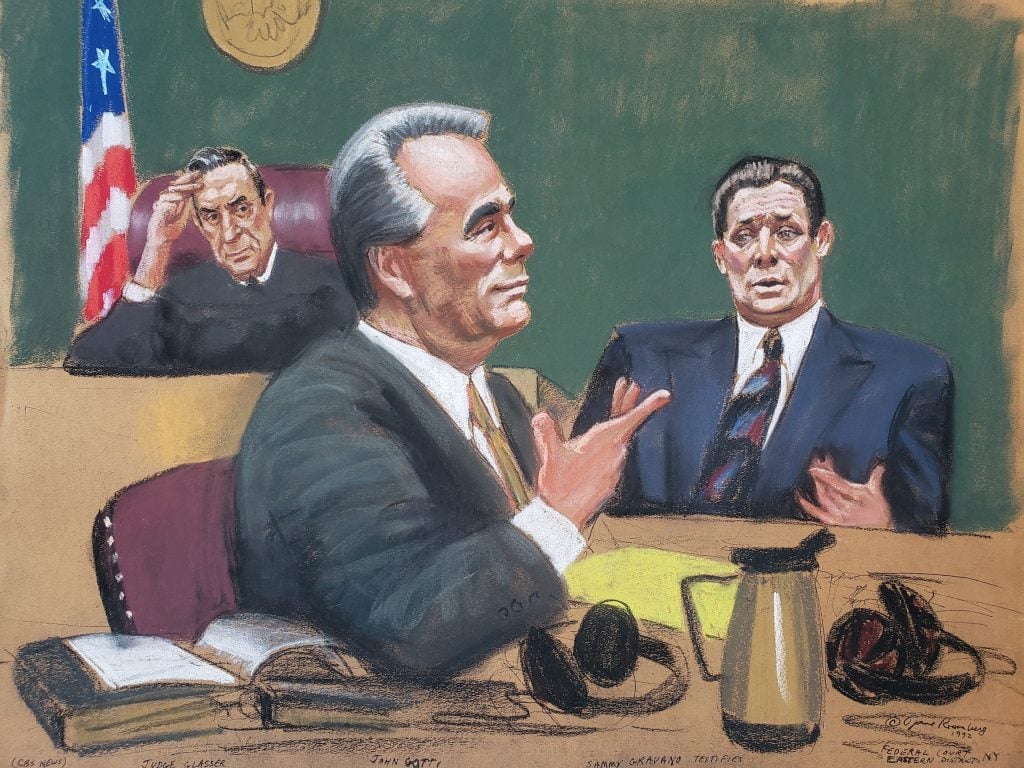Art World
Meet the Courtroom Artist Who Has Drawn Miscreants From Martha Stewart to Martin Shkreli
A new memoir by Jane Rosenberg recounts her time drawing defendants in some of the country's highest-profile cases.

A new memoir by Jane Rosenberg recounts her time drawing defendants in some of the country's highest-profile cases.

Brian Boucher

Courtroom artist Jane Rosenberg will be the first to tell you that her trade may well be hanging by a thread, as cameras seem always to be poised to penetrate even the sacred space of federal courtrooms. But she’s been telling herself that for years, and yet the rules remain in place that attempt to keep at least some trials from becoming even worse media circuses than they are already are.
In her lively and engaging new memoir, Drawn Testimony, now out from Hanover Square Press, Rosenberg recounts an unlikely career that took her from family portraits at the mall to a ringside seat at some of the most consequential trials of our time, with defendants including John Gotti, Joaquín “El Chapo” Guzmán, Ghislaine Maxwell, Donald Trump, and Harvey Weinstein. (She has also drawn at least one art world star: silky-voiced ex-Metropolitan Museum of Art director Philippe de Montebello was called as a witness in the elder abuse trial involving major arts philanthropist Brooke Astor, aka “New York’s fairy godmother.”)
“I was a starving artist,” she said, looking back on the arc of her career in a phone interview on a rare day off between working the courtrooms in high-profile cases like the bribery and campaign finance offenses case against New York mayor Eric Adams and the sex trafficking and racketeering trial of music mogul Diddy. “It was a rough beginning. I didn’t even talk in the book about how bad it was for me back then.
“Now I’m working all the time,” she said, “so I’m not a starving artist anymore, though I do get hungry a lot. But I feel pretty good about where I’m at with my career.”

Jane Rosenberg’s drawing of Bernie Madoff. Courtesy of Jane Rosenberg.
Raised by an amateur painter mother, a crafty grandmother, and a furniture-building father, she read about the Ashcan School as a kid and loved Reginald Marsh’s and John Sloan’s paintings—seeing in them, in retrospect, a group portraiture akin to what she does today. She also places her own work in a lineage that goes back to Honoré Daumier’s courtroom lithographs of the 1860s.
Instructed at art school with with a steady diet of Abstract Expressionism, Rosenberg was forced into becoming a closet self-portraitist. Later, more to her liking, she studied painting and anatomy at New York’s venerable Art Students League with portraitist David Leffel. She plied her trade in all sorts of ways. Illustrations for adult magazines? Affirmative. Chalk renditions of Vermeers and Rembrandts on the sidewalk, with a hat out to collect donations? Yep. Family portraits at Christmastime? She’s done it.
Her life changed in 1980, when she saw courtroom artist Marilyn Church give a lecture at New York’s Society of Illustrators and thought maybe she could do the same.
“I didn’t think I was good enough,” she said, “but I looked in the mirror and thought, ‘That’s it, I really want to try this.’”
A gutsy Rosenberg cold-called NBC and was invited to come in and show them her work, and suddenly she was a professional. “I saw my work on my black-and-white television,” she said. “I was so excited.”
Since then, she’s come into such high demand that she’s been helicoptered in to high-profile trials; her drawing of a frowning Donald Trump was the first courtroom sketch ever to grace the illustrator’s holiest of holies: the cover of the New Yorker, whence it went globally viral.
Funny enough, she has occasionally found herself in unexpected interactions with her subjects. Sex offender Jeffrey Epstein’s accomplice Ghislaine Maxwell once tried to turn the tables, swiveling around to face the artist, whipping out a sketchpad, and going to work on her own drawing. Rosenberg’s drawing of Maxwell at work also went viral. Later, when Maxwell again spun around and sketched Rosenberg during a break, another artist entered the courtroom and drew the two of them drawing each other. “In a career with no shortage of them,” she wrote, “it was one of the more surreal moments.”

Jane Rosenberg’s drawing of John Gotti. Courtesy of Jane Rosenberg.
Mob boss John Gotti (nicknamed the “Teflon Don” for the way that it seemed no charges would ever stick to him) also once looked at the courtroom artists; he gestured at his face, apparently disgruntled that he had been depicted with a double chin. While she never interacted with “pharma bro” Martin Shkreli, she suspected that he too aimed to throw the artists off balance: he would sometimes, during a break in the trial, part his floppy black hair on the opposite side. (At first she felt obliged to restart the drawing each time; she later decided to stick with whatever side the part was on to begin with.)
She’s also learned that not every drawing scores a win. Her rendition of quarterback Tom Brady during the Deflategate scandal, for one, was lampooned for failing to capture his notably handsome features. But in the end, she makes a compelling argument for handcraft in place of cameras. “The pastel in place of the pixel,” she wrote, can be expressive, conveying dynamism, depth and emotion in its own way. And even the sometimes harsh glare of social media can shed fresh light on a nearly obsolete profession, she added, highlighting, by contrast to the camera, something “quaint and esoteric” about her drawings.

Jane Rosenberg’s drawing of Martha Stewart. Courtesy of Jane Rosenberg.
Rosenberg offers a thorough, engrossing account of her craft and everything that surrounds it, from the cases she uses to carry her pencils to the changing infrastructure of the media. Even her sandwiches, on soft challah bread for easy gulping during short lunch breaks in the midst of sometimes marathon days, are made strategically.
Her procedure for packing her supplies, spreading them out around her in the courtroom, and scrubbing her sometimes bleeding hands in the evening (out, damn chalk!), is vividly laid out. She often has to draw a crucial moment that passes—well, in just a moment. And when witnesses recount the worst moments of their lives, sometimes tearfully and in agonizing detail, she has to remain detached, she wrote, “to a point that can feel uncomfortably calculating.”
And while it’s true that cameras aren’t allowed in the courtroom, they have always been part of the procedure. She started out in the days when photographers shot her drawings after taping them to the side of a truck, and then handed the film off to motorcycle couriers who rushed it to the newsroom. Now, a smartphone gets the job done.
“I remember my very first answering machine,” she said. “It was the size of a suitcase and it cost me $400, but it was so worth it, because I wouldn’t miss my calls for work. Back then, there was no digital anything. Soon after that I got a pager.”
These days, computer monitors on the tables, and even the judge’s bench, make her job more challenging, she said, by blocking her views. And there’s always that threat of more and more cameras, she acknowledged.
“But I’m busy enough with federal court,” she said, “and if it all goes away I’ve had 44 years. It’s been a really good run. I’m beyond retirement age but I keep working because life is expensive. I really do have quite a history. I can’t complain.”
Rosenberg will engage in a conversation with artist Guy Richards Smit at her alma mater, the Art Students League, 215 West 57th Street, New York at 6 p.m. on October 22.